- Premium features included
- No hidden costs or usage limits
- Scale from startup to enterprise


Remember when blogging platforms were simple? Before WordPress became a Swiss Army knife of features you’ll never use? Ghost emerged from that exact frustration in 2013, and honestly, it’s refreshing to see an email platform that knows exactly what it wants to be: a clean, fast way to publish content and build an audience.
Picture this: you sit down to write, and the platform just… works. No plugin conflicts, no database bloat, just you and your words. That’s Ghost in a nutshell — an open-source publishing platform built on Node.js that moves like lightning and stays out of your creative process.
You’ve got two ways to run it: grab the code and host it yourself if you’re technically inclined, or let Ghost (Pro) handle the messy server stuff while you focus on creating.
What makes Ghost different? It’s not trying to be everything. While WordPress morphed into a website builder that happens to have a blog, Ghost stayed laser-focused on publishing. Built-in memberships, native newsletters, and SEO tools come standard — no Frankenstein plugin setup required. The whole thing runs on Node.js, which means your pages load before readers get impatient and bounce.
Ghost’s email system lives right inside the platform — write once, publish everywhere. When you hit publish, your content can go live on your site and shoot out to subscribers’ inboxes simultaneously. No juggling between your CMS and Mailchimp. The newsletter builder gives you enough control to make emails look professional (custom headers, colors, typography) without drowning in options.
You can slice your audience however you want: free members only, paid subscribers, specific tiers, or custom labels you’ve created. Testing matters, so Ghost lets you send yourself preview emails before blasting your entire list. And yes, all the boring compliance stuff like unsubscribe links and bounce handling happens automatically. Ghost(Pro) users don’t even think about email delivery — it just works.
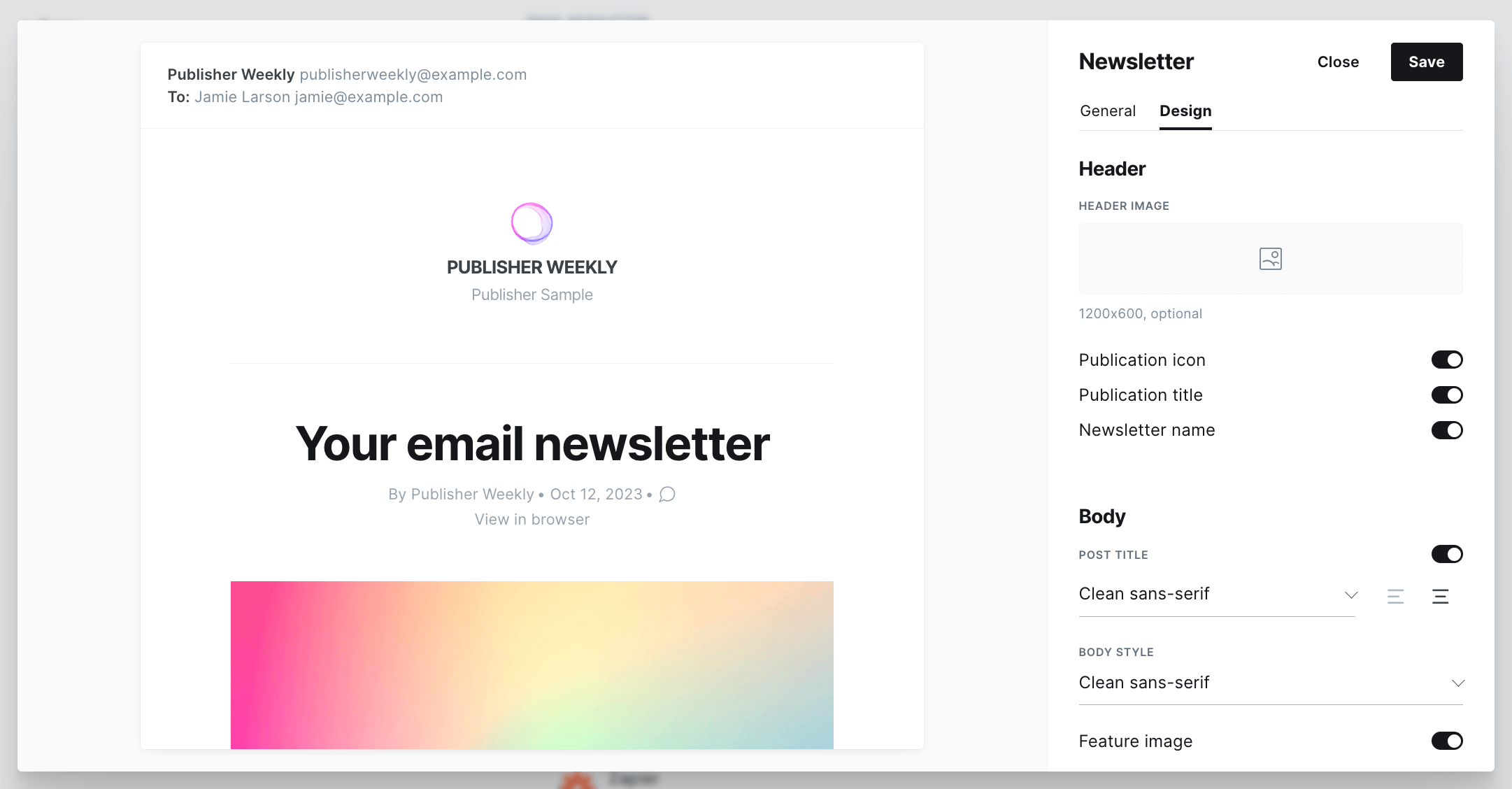
Every email Ghost sends looks good, period. The templates are tested across Gmail, Outlook, Apple Mail — all the usual suspects — so you don’t get those embarrassing formatting disasters. The responsive design means your newsletter looks sharp whether someone’s reading on their phone during their commute or on a desktop at work.
Want multiple newsletters? Go for it. Create a weekly roundup for casual readers and a deep-dive series for paying members. Each can have its own look and subscriber list. The editor gives you drag-and-drop control over the visual stuff, but it’s not overwhelming. Dynamic content cards let you embed products, CTAs, or member-only teasers without touching code.
Let’s be real: Ghost isn’t trying to be HubSpot. Its automation focuses on the basics that actually matter for publishers. Hit publish once, and your post goes live while emails fly out to the right segments. New subscriber? They get a welcome email automatically. Payment failed? Ghost handles the retry logic.
The magic happens when you connect Ghost to other tools through Zapier or webhooks. Suddenly, new members trigger Slack notifications, published posts create social media drafts, and subscriber data syncs with your CRM. But if you’re looking for complex drip campaigns with behavioral triggers? Ghost keeps it simple — maybe too simple for some.
The member dashboard tells you what you need to know without information overload. Watch your subscriber count climb, track which posts convert free readers to paid members, see where people drop off. It’s enough data to make smart decisions without drowning in analytics paralysis.
Membership tiers let you get creative with pricing. Maybe $5/month for the newsletter, $15 for exclusive content, $50 for everything plus monthly Zoom calls. Labels help you tag and segment beyond the basic paid/free split — think “founding members” or “workshop attendees.”
Ghost tracks where each member came from (Twitter, Google, that viral post), so you know what’s actually working. Stripe handles the money stuff, keeping you PCI compliant without the headache.
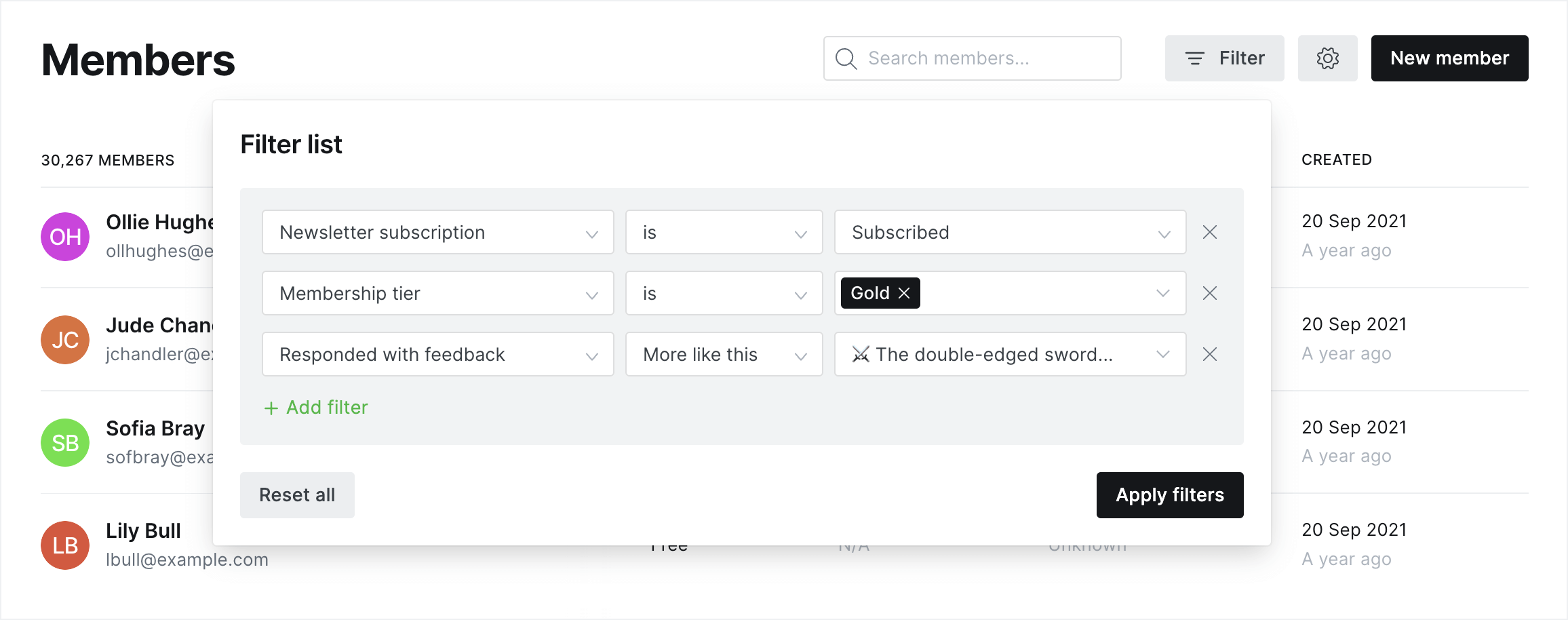
Ghost’s landing pages won’t win design awards, but they convert. The theming system lets you build dedicated signup pages, about sections, or resource libraries that match your main site. Forms pop up where you need them — inline with content, as exit-intent popups, or on dedicated subscription pages.
The member portal is surprisingly polished. Subscribers manage their own preferences, update credit cards, download invoices — all the self-service stuff that would otherwise flood your inbox.
You can add custom fields to collect more than just email addresses (job title, interests, whatever helps you understand your audience). Some users run A/B tests on different form placements, though it takes a bit of creativity since it’s not built-in.
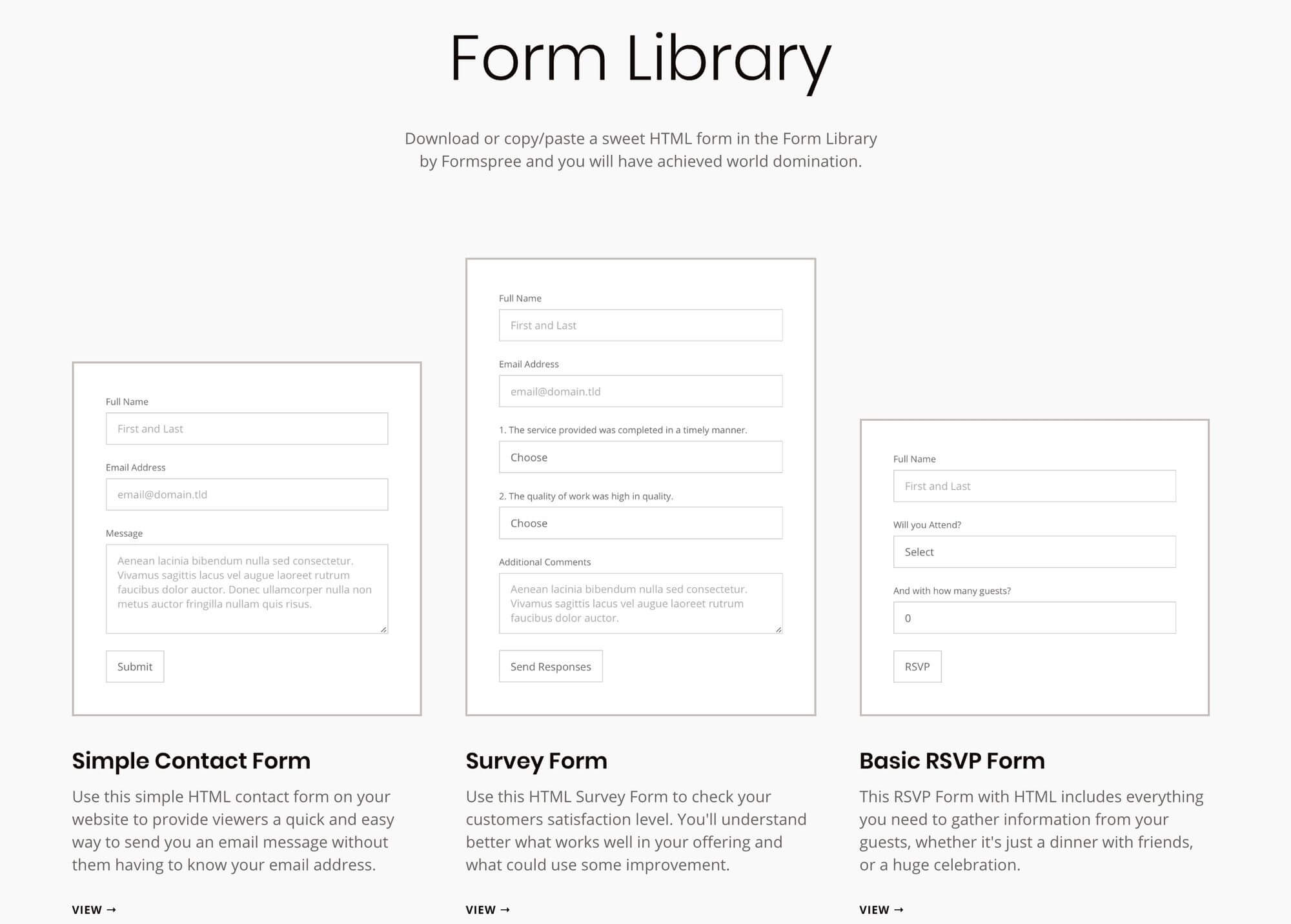
Ghost 6.0 finally brought native analytics that don’t require a computer science degree to understand. Open rates, click rates, engagement trends — it’s all there in the dashboard, updated in real-time. No more jumping between Ghost and Google Analytics just to see how your last post performed.
For paid newsletters, the revenue metrics are gold. Watch monthly recurring revenue, track churn, calculate customer lifetime value. You can see which posts drive the most upgrades from free to paid.
Member attribution shows the full journey — someone read three free posts, hit the paywall on the fourth, then subscribed. Integration with Google Analytics still works if you need deeper dives into user behavior.
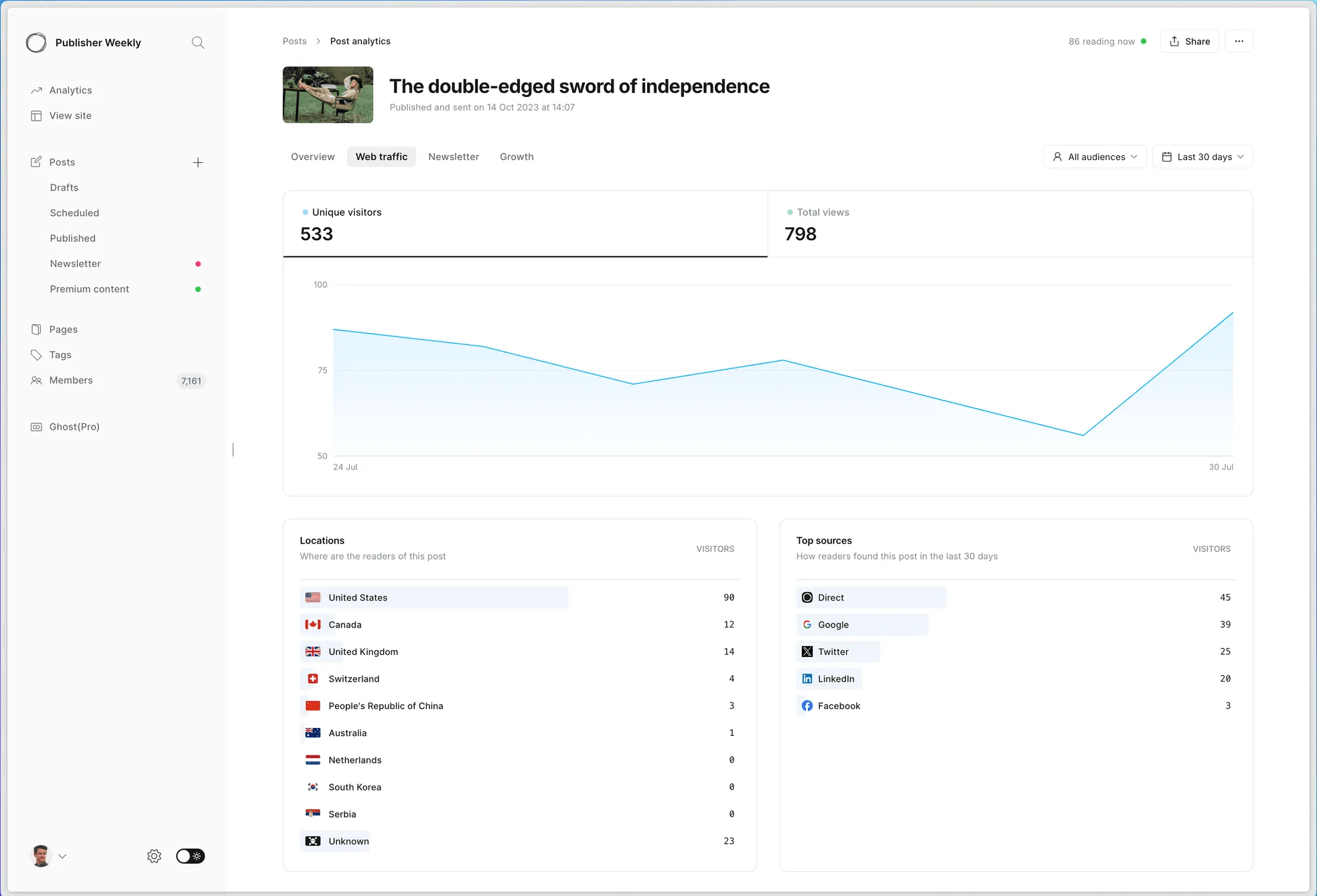
Ghost plays nice with others. The Content API and Admin API let developers build whatever custom integrations they dream up. Running Ghost as a headless CMS for your React app? No problem. Want to pull subscriber data into your data warehouse? The APIs are there.
Out of the box, you get official integrations with the usual suspects: Zapier for automation, Slack for notifications, Google Analytics for tracking. Webhooks fire when things happen — new post published, member subscribed, payment received. Custom themes use Handlebars templating, which feels dated but works reliably. The REST API documentation is actually readable, which is more than most platforms can say.
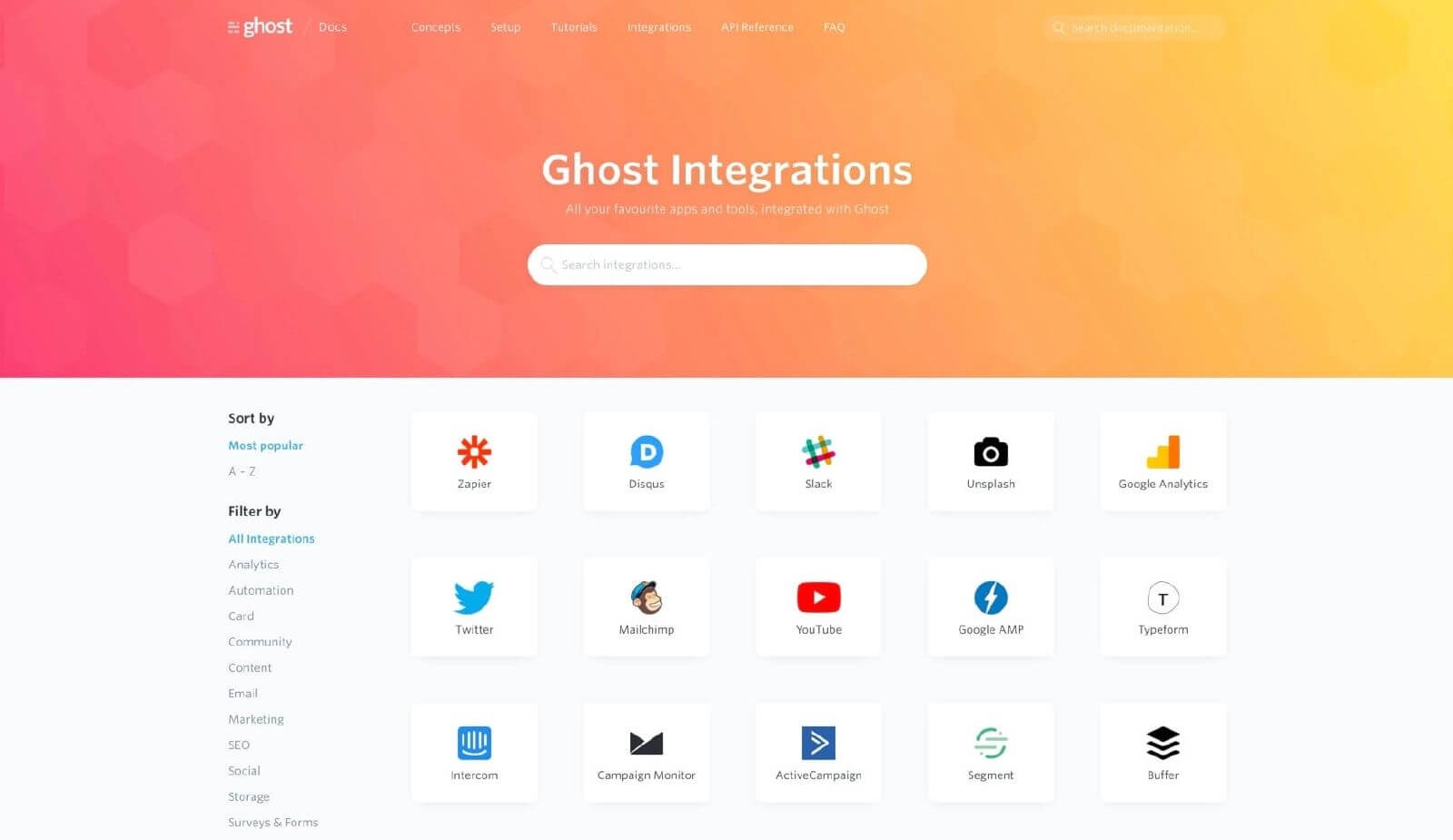
Here’s where things get interesting. Ghost(Pro)’s support depends on what you’re paying. The basic tier gets you Monday-Friday email support — no weekend coverage — which has frustrated more than a few users. Spring for the higher tiers, and response times improve dramatically.
The documentation is solid, covering everything from basic setup to advanced theme development. The community forum surprises with how helpful people are, though you’re rolling the dice on response times. Self-hosted users are basically on their own unless they hire a developer. It’s the trade-off for going the DIY route.
Ghost’s pricing model is refreshingly straightforward. No transaction fees eating into your revenue — just pay for hosting and keep everything you earn.
Plan
Price (Annual)
Members Limit
Key Features
Self-Hosted
Free (+ hosting costs)
Unlimited
Total control, need tech skills, all features unlocked
Starter
$9-18/month
500-1,000
Managed hosting, automatic updates, email support
Creator
$25-29/month
1,000-2,000
Faster support, custom themes, priority features
Business
$199+/month
10,000+
White-glove support, custom integrations, uptime guarantee
Ghost absolutely flies. We’re talking sub-second page loads that make WordPress sites feel like they’re running through molasses. Google loves fast sites, and Ghost delivers without any optimization plugins or CDN configuration. The zero platform fee philosophy means if you make $10,000 from subscriptions, you keep $10,000 (minus Stripe’s cut, obviously).
The writing experience feels like someone actually thought about writers for once. Markdown support for speed demons, rich editor for visual folks, and it all stays out of your way. Memberships and payments work right out of the box — no WooCommerce wrestling or MemberPress configuration marathons. Your content, your subscribers, your payment relationships — you own it all.
And the SEO stuff? Automatic sitemaps, structured data, social cards — it’s handled without you lifting a finger.
If you’re coming from Mailchimp or ConvertKit, Ghost’s email features feel basic. No sophisticated automation sequences, limited segmentation options, and forget about behavioral triggers. Self-hosting requires actual technical chops — we’re talking command line, server management, the works. Not exactly beginner-friendly.
Want to customize your theme beyond basic colors? Better know some HTML and CSS. That beautiful theme marketplace WordPress has? Ghost’s is tiny by comparison. The Mailgun-only email requirement annoys plenty of users who prefer SendGrid or Amazon SES. And that weekend support limitation on lower tiers? Your site goes down Saturday morning, you’re waiting until Monday for help.
Best For
Not Recommended For
Serious writers who value speed
Ecommerce stores needing catalogs
Newsletter publishers wanting integration
Visual builders and drag-and-drop fans
Paid newsletter businesses
Marketing automation power users
Developers building custom platforms
Multi-language sites
SEO-obsessed content creators
Plugin collectors
Professional writers and journalists love Ghost because it gets out of the way. No feature creep, no plugin conflicts, just a clean space to write and publish. If you’re monetizing through subscriptions and tired of Substack taking 10%, Ghost’s zero-fee model starts looking really attractive.
Digital publications that need speed and scale find Ghost’s architecture perfect. Newsletter creators graduating from Mailchimp get everything in one place without the complexity. Developers building custom publishing platforms appreciate the clean APIs and predictable behavior. Anyone who’s fought with WordPress performance issues sees Ghost’s speed as a revelation.
Running an online store? Ghost isn’t built for that — grab Shopify or WooCommerce instead. If you need visual page builders and drag-and-drop everything, you’ll find Ghost frustrating. Marketing teams expecting sophisticated marketing automation should check out Sender, which offers proper email marketing features at competitive prices without the platform lock-in.
Hobby bloggers wanting free hosting and infinite plugins will be happier with WordPress.com. Large newsrooms needing complex editorial workflows might find Ghost too simple. And if you’re building a multi-language site? Ghost doesn’t really do that well.
G2 users give Ghost 4.1 out of 5 stars, and the pattern is clear: writers love it, marketers find it limiting. The speed difference from WordPress gets mentioned constantly — people seem genuinely surprised their sites can load that fast. The clean interface wins fans who are tired of cluttered dashboards and menu sprawl.
The complaints? Usually from folks expecting WordPress-level customization options. “Where are all the plugins?” comes up a lot. But users running membership sites rave about how simple Ghost makes the whole subscription business. The writing experience gets called “sublime,” “distraction-free,” and “actually enjoyable” — high praise in the CMS world.
Capterra’s 4.7-star rating tells a similar story. Small publishers and content creators sing Ghost’s praises, especially those who’ve successfully migrated from WordPress. The word “simple” appears in nearly every positive review, usually as a compliment. Performance improvements after switching get specific mentions — “50% faster,” “Core Web Vitals all green,” that sort of thing.
The learning curve frustrates non-technical users, though many admit it’s worth it once they adjust. Pricing comes up as both a pro and con — some love the transparent pricing and no commission fees, others find the entry-level hosting costs steep compared to shared WordPress hosting.
Trustpilot’s 2.1 stars reflect a wider range of user experiences. Happy customers focus on the publishing experience and lack of bloat. One reviewer nailed it: “They are extremely focused on publishing and that’s the beauty: you can’t mess up.” The frustrated reviews? Mostly about support response times and refund policies.
Technical users praise the headless CMS capabilities and API flexibility. Several mention building entire businesses on Ghost’s infrastructure. But beginners expecting WordPress-style hand-holding leave disappointed. The divide is pretty clear: if you want simplicity and speed over features, you’ll probably love it. If you need everything and the kitchen sink, you won’t.
Ghost handles publishing brilliantly, but Sender runs circles around it for email marketing. Where Ghost gives you basic newsletters and segmentation, Sender delivers proper automation workflows, A/B testing, and behavioral triggers starting at just $7/month. Their free plan supports 2,500 subscribers with features Ghost doesn’t even offer in paid tiers.
But here’s the thing: Ghost isn’t trying to be an email marketing platform. It’s a publishing system that happens to send newsletters. The SEO tools, content management, and page speed blow Sender away because, well, Sender isn’t a CMS. If you need both? Run Ghost for your site and connect Sender for serious email marketing. Best of both worlds.
When comparing Ghost vs Beehiiv, both platforms make newsletter publishing easy—but they serve slightly different creators. Ghost is perfect if you want full control and own your content; it’s open-source, self-hosted, and doubles as a blogging and membership platform.
Beehiiv, on the other hand, is built for growth—it’s beginner-friendly, includes referral programs, audience segmentation, and monetization tools out of the box. Ghost feels more like running your own media site, while Beehiiv feels like running a Substack on steroids. If you care about customization and independence, go Ghost; if you want speed and built-in growth features, go Beehiiv.
Money talks: Ghost takes 0% of your revenue, Substack takes 10%. On $5,000 monthly revenue, that’s $500 staying in your pocket with Ghost. But Substack’s network effects are real — their recommendation system and Notes feature can jumpstart audience growth in ways Ghost can’t match.
Ghost gives you complete control — your design, your domain, your data. Substack gives you simplicity — sign up and start writing in minutes, zero technical knowledge required. Ghost requires hosting investment upfront; Substack is free until you charge for subscriptions. Pick Ghost if you want to own your platform. Pick Substack if you want to rent convenience and don’t mind the landlord taking a cut.
Ghost isn’t trying to be everything to everyone, and that’s exactly why it works. For serious publishers who care more about writing and monetizing than widgets and plugins, it’s probably the best option available. The speed is addictive, the writing experience is genuinely pleasant, and keeping 100% of your subscription revenue feels like how things should work.
Yeah, the technical requirements scare off beginners, and the email features won’t satisfy power marketers. If you need sophisticated automation, pair it with something like Sender or accept the limitations.
But for what it’s designed to do — let writers write, publishers publish, and creators create without the usual CMS nonsense — Ghost nails it. Sometimes the best feature isn’t what a platform includes, but what it leaves out.
